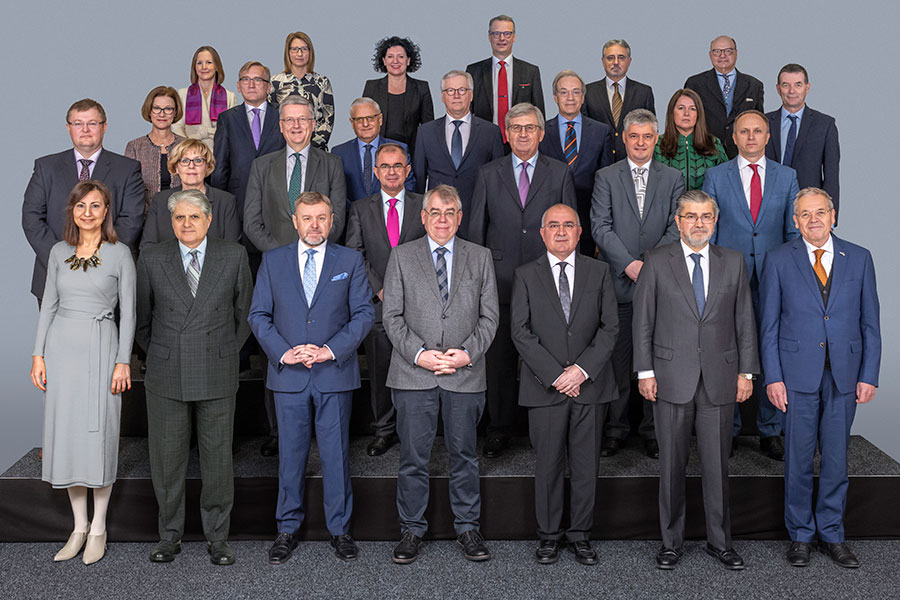Introducing the 2019 annual reports of the European Court of Auditors
A word on the ‘2019 EU audit in brief’
The ‘2019 EU audit in brief’ provides an overview of our 2019 annual reports on the EU’s general budget and the European Development Fund, in which we present our statement of assurance as to the reliability of the accounts and the legality and regularity of the transactions underlying them. It also outlines our key findings regarding revenue and the main areas of spending under the EU budget and the European Development Fund, as well as findings relating to budgetary and financial management, and follow-up of our previous recommendations.
The full texts of the reports may be found at eca.europa.eu.
The European Court of Auditors (ECA) is the independent external auditor of the EU. We warn of risks, provide assurance, highlight shortcomings and good practice, and offer guidance to EU policymakers and legislators on improving the management of EU policies and programmes. Through our work we ensure that EU citizens know how their money is being spent.
President’s foreword

Our annual report on the 2019 financial year, the last but one in the period for 2014-2020, has been finalised during challenging times for the EU and its Member States. We, as the European Union’s external auditor have done everything we can, to continue providing an effective public audit service in the EU since the outbreak of the COVID-19 pandemic.
As in previous years, we conclude that the EU accounts present a true and fair view of the EU’s financial position. We give a clean opinion on the reliability of the 2019 accounts of the European Union. The revenue for 2019 was legal and regular, and free from material error.
For 2019, our estimate for the overall error rate in the audited expenditure is 2.7 % (2018: 2.6 %).
There are certain positive developments in significant areas of EU spending. Where we provide a specific assessment, the level of error is below materiality in ‘Administration’; for ‘Natural resources’, considering our estimated level of error (1.9 %) and other evidence available, we find it to be close to materiality. It should be noted that Direct Payments, representing 70 % of ‘Natural resources’ expenditure, were significantly below the materiality threshold. At the same time, the remainder of ‘Natural resources’, ‘Cohesion’ and ‘Competitiveness’ continue to be affected by material error.
For several years we have audited the EU revenue and spending by differentiating between those budget areas where we consider the risks to legality and regularity high, and those where we consider them low. During the last three years, we had issued a qualified opinion on expenditure. According to international auditing standards, we could do this because we considered that errors were not pervasive and mainly confined to high-risk expenditure.
Due to the way the EU budget is composed and evolves over time, the proportion of high-risk expenditure in the audited population has increased from €61 billion in 2018 to €66.9 billion. In 2019, it represents a substantial proportion of around 53 % of our 2019 audit population. At the same time, material errors continue to be present in high-risk expenditure: we estimate the level of error in this type of expenditure at 4.9 % (2018: 4.5 %). Against this background, we issue an adverse opinion on expenditure.
In July 2020, the European Council reached a political agreement on the multiannual financial framework (MFF) for 2021-2027 and the temporary recovery instrument, the ‘Next Generation EU’. This agreement marks a historic shift in the EU’s finances. The EU will spend significantly more than in the previous seven-year period to address the economic and social impact of the COVID-19 crisis, with EU payments practically increasing twofold in the first years. In these times of crisis, it is vital that EU spending delivers results quickly and thus demonstrates the added value of European cooperation and solidarity.
Managing the EU’s finances in a sound and effective manner will thus become even more important. This entails an increased responsibility for both the Commission and the Member States, but also for us at the European Court of Auditors. In the years to come, we will continue to play an active and visible role in supporting accountability and transparency for all forms of EU finances, looking at both the EU budget and the financial support provided through the ‘Next Generation EU’ instrument.

Klaus-Heiner LEHNE
President of the European Court of Auditors

Overall results
Key findings
Summary of the 2019 statement of assurance
The ECA gives a clean opinion on the reliability of the 2019 accounts of the European Union.
Revenue for 2019 was legal and regular, and free from material error.
Our opinion on expenditure for the 2019 financial year is adverse.
- Overall, the estimated level of error in expenditure from the 2019 EU budget was at 2.7 % (2018: 2.6 %). High-risk expenditure (mainly reimbursement-based), which is often subject to complex rules, was affected by a material level of error at 4.9 % (2018: 4.5 %). This year, largely due to a rise in ‘Cohesion’, the proportion of this expenditure-type increased to 53.1 %, representing a substantial part of our audit population. Unlike the previous three years, the error is therefore pervasive, which is the basis for an adverse opinion on expenditure.
- Weaknesses in ex-post checks affect the European Commission’s regularity information. This is reflected in its estimates of ‘risk at payment’, which are lower than our estimates of the levels of error for ‘Cohesion’ and for ‘Competitiveness’. For ‘Natural resources’, the Commission’s estimate of the risk at payment is consistent with our estimate.
- In 2019, there was a significant increase in payment claims for the European Structural and Investment (ESI) funds in ‘Cohesion’. At the same time, in the sixth year of the 2014-2020 multi-annual financial framework (MFF), the use or ‘absorption’ of ESI funds by Member States has remained slower than planned. This has contributed to an increase in outstanding commitments for the ESI funds.
- We report all suspected fraud cases detected during our audit work to the EU’s anti-fraud office (OLAF). There were nine such cases out of the 747 transactions we examined for our 2019 statement of assurance.

The full text of our 2019 annual reports on the EU budget and on the activities funded by the 8th, 9th, 10th and 11th European Development Funds can be found on our website (eca.europa.eu).
What we audited
2019 EU budget in figures
The European Parliament and the Council adopt an annual EU budget, within the framework of a longer-term budget agreed for a period of several years (known as the ‘multiannual financial framework’ or MFF). The current period runs from 2014 to 2020.
Ultimate responsibility for ensuring that the budget is properly spent lies with the Commission. In 2019, spending totalled €159.1 billion, the equivalent of 2.1 % of the total general government spending of EU Member States and 1.0 % of EU gross national income.
Where does the money come from?
In total, for 2019, revenue amounted to €163.9 billion. The EU budget is financed by various means. The largest share (€105.5 billion) is paid by Member States in proportion to their gross national income (GNI). Other sources include customs duties (€21.4 billion), the contribution based on value-added tax collected by Member States (€17.8 billion) and, for example, contributions and refunds arising from European Union agreements and programmes (€12.6 billion).
What is the money spent on?
The EU budget is spent on a wide range of areas, such as:
- fostering the economic development of structurally weaker regions;
- promoting innovation and research;
- transport infrastructure projects;
- training for unemployed people;
- farming and promoting biodiversity;
- fighting climate change;
- border management;
- aid for neighbouring and developing countries.
About two thirds of the budget is spent under what is known as ‘shared management’, with Member States distributing funds, selecting projects and managing the EU’s expenditure (as in the case of e.g. ‘Natural resources’ or ‘Cohesion’).
Our statement of assurance on the EU budget
Every year, we audit EU revenue and expenditure, examining whether the annual accounts are reliable and whether the underlying income and expenditure transactions comply with EU and national rules.
This work forms the basis for our statement of assurance to the European Parliament and the Council in accordance with Article 287 of the Treaty on the Functioning of the European Union (TFEU). We examine expenditure at the point when final recipients of EU funds have undertaken activities or incurred costs, and when the Commission has accepted this expenditure. In practice, this means that our population of transactions covers interim and final payments. We did not examine pre-financing payments unless they had been cleared in 2019.
Our audit population for 2019 amounted to €126.1 billion. Figure 1 presents the 2019 payments per MFF heading and the population that was subject to our audit.
Figure 1
2019 payments and audited population

This year, ‘Natural resources’ made up the largest share of our overall audit population (47 %), followed by ‘Cohesion’ (23 %) and ‘Competitiveness’ (13 %).
For more information on our audit approach and how we arrive at our opinion on expenditure, see Background information.
What we found
EU accounts present a true and fair view
The 2019 EU accounts present fairly, in all material respects, the EU’s financial results and its assets and liabilities at the end of the year, in accordance with international public-sector accounting standards.
We can therefore give a clean opinion on the reliability of the accounts, as we have done every year since 2007.
Revenue for 2019 is legal and regular
We conclude that revenue is free from material error. Moreover, we examined selected revenue-related systems and assessed them as effective overall, with the exception of key internal controls for traditional own resources (TOR) at the Commission and in certain Member States, which we found to be partially effective. We also found important weaknesses in Member States’ controls to reduce the customs gap; these weaknesses require EU action.
Our error estimate for 2019 has increased
For expenditure as a whole, we estimate the level of error to be between 1.8 % and 3.6 %. The mid-point of this range, known as the ‘most likely error’, is 2.7 % (see Figure 2). This is an increase compared to the two previous years (2017: 2.4 %, 2018: 2.6 %).
Figure 2
Estimated level of error for the EU budget as a whole

Note:
We use standard statistical techniques to estimate the level of error. We are 95 % confident that the level of error for the population lies in the range between the lower and upper error limits (for more details, see Chapter 1, Annex 1.1 to the 2019 annual report).
More than half of our audit population is affected by material error
In 2019, we once again found that the way expenditure was disbursed has an impact on the risk of error. We distinguish in this context between high-risk, mainly cost-reimbursement and low-risk, mainly entitlement-based payments (see box below).
What are entitlement and cost reimbursement payments?
EU spending is characterised by two types of expenditure involving distinct patterns of risk:
- entitlement payments, which are based on beneficiaries meeting certain (less complex) conditions: these include student and research fellowships (under ‘Competitiveness’), direct aid for farmers (‘Natural resources’) and salaries and pensions for EU staff (‘Administration’);
- cost reimbursements, where the EU reimburses eligible costs for eligible activities (involving more complex rules): these include research projects (under ‘Competitiveness), investment in regional and rural development (‘Cohesion’ and ‘Natural resources’) and development aid projects (‘Global Europe’).
The most common errors we found in the high-risk expenditure were:
- ineligible projects and infringements of internal market rules (in particular non-compliance with public procurement rules) in ‘Cohesion’;
- ineligible beneficiaries, activities or costs for ‘Rural development, market measures, the environment, climate action and fisheries’, representing around 30 % of payments in ‘Natural resources’;
- ineligible costs for ‘Research’, responsible for programmes representing around 55 % of payments in ‘Competitiveness’; and
- non-compliance with public procurement rules, irregular grant award procedures, absence of supporting documents and ineligible costs in ‘Global Europe’.
In 2019, high-risk expenditure increased compared to the previous three years and made up the majority, 53 %, of our audit population This increase is largely due to a €4.8 billion increase in our ‘Cohesion’ audit population. The estimated level of error for high-risk expenditure was 4.9 % (4.5 % in 2018).
The most likely error rate estimated for low-risk expenditure (which accounted for the remaining 47 % of our audit population and mainly included entitlement-based payments) was below our materiality threshold of 2 % (see Figure 3).
Figure 3
Error rates reflect the level of risk

Figure 4 compares the estimated levels of error in the various spending areas between 2015 and 2019. Further information on results are provided in the chapter A closer look at revenue and spending areas and in the relevant chapters of our
Figure 4
Our error level estimates for selected EU spending areas

Note:
The estimated level of error is based on quantifiable errors we identified through our work, notably by testing a sample of transactions. We use standard statistical techniques to select this sample and estimate the level of error (see Chapter 1, Annex 1.1 to the 2019 annual report).
Comparison between the Commission’s and our estimated level of error
Each Commission directorate-general (DG) produces an annual activity report. This includes a declaration in which the Director-General provides assurance that the report properly presents financial information and that transactions under his/her responsibility are legal and regular. For this purpose, all DGs provide estimates of the levels of error in their spending.
For those MFF headings for which we provide a specific assessment, we compared the Commission’s estimates with our own estimated levels of error.
The comparison shows that the Commission figures are below our estimates for ‘Competitiveness’ and ‘Cohesion’. This reflects the weaknesses we found in ex post audits, which are a critical part of the control system. We report in more detail on these weaknesses in the parts dealing with the different MFF headings.
Overall, the Commission’s estimate of the risk at payment for 2019 is 2.0 %. This is at the lower end of the range of our own error estimates (between 1.8 % and 3.6 %).
We reported nine suspected fraud cases to OLAF
A fraudster is someone who falsifies a document, or hides information, in order to obtain a financial or other economic advantage. Our estimate of the level of error in the EU budget is therefore neither a measure of fraud nor of inefficiency or waste. Rather, it is an estimate of the money that was not used in accordance with the applicable rules and regulations and therefore should not have been paid out.
We report all suspected fraud cases detected during our audit work to the EU’s anti-fraud office, OLAF, which then decides whether to investigate and follow up these cases, where appropriate in co-operation with national judicial authorities. In 2019, we referred to OLAF nine suspected fraud cases out of the 747 transaction examined for our 2019 statement of assurance, similar to the number of cases reported in previous years. Out of these cases, OLAF has opened five investigations. In four cases, OLAF decided not to open an investigation.

Want to know more? Full information on the main findings can be found in Chapter 1 of our 2019 annual report. The full text of our annual report can be found on our website (eca.europa.eu).
Budgetary and financial management in 2019
The available budget has been almost fully implemented
The MFF Regulation sets maximum amounts for each of the seven years of the MFF (‘MFF ceilings’). Separate ceilings are set for new EU financial obligations (commitment appropriations) and for payments that can be made from the EU budget (payment appropriations).
Figure 5
Budget implementation in 2019

In 2019, Commitment appropriations were almost fully used: €165.2 billion out of the final budget of €166.2 billion (99.4 %). As permitted by Article 3(2) of the MFF Regulation, these appropriations and their use slightly exceeded the MFF ceiling (€164.1 billion). This was mainly due to the use of special instruments (such as the Emergency Aid Reserve, the European Union Solidarity Fund, the Flexibility Instrument, the European Globalisation Adjustment Fund, the Contingency Margin, the specific flexibility to tackle youth unemployment and strengthen research, and the global margin for commitments).
In 2019, €166.7 billion was available for payment appropriations, as per the MFF ceiling, and €148.5 billion as per the budgetary authority’s final budget. The amount paid out was €146.2 billion, €19 billion less than the amount committed.
Outstanding commitments continue to increase
Outstanding commitments have continued to rise, reaching €298.0 billion by the end of 2019 (see Figure 6). In 2019, they were equivalent to 2.7 years of commitment appropriations, a rise from 2.3 years in 2012, the corresponding year of the previous MFF. The two main reasons for the historically high level of outstanding commitments are commitment appropriations systematically exceeding payment appropriations, and payment needs being postponed to the next MFF, mainly due to the delays in ESI funds implementation.
Figure 6
Outstanding commitments at year end

Slower absorption of ESI funds than under the previous MFF
By the end of 2019, the rate of cumulative absorption from the ESI funds remained lower than under the previous MFF: only 40 % of the total ESI fund allocations (€465 billion) for the current MFF had been paid out, compared with 46 % by the end of 2012, the corresponding year of the previous MFF. Only nine Member States had higher absorption rates under the current MFF than under the previous one (see Figure 7).
Figure 7
Absorption rate by Member State – 2019 versus 2012

Less than a fifth of EU support through financial instruments under shared management had reached final recipients
Financial instruments under shared management (FISMs) are a delivery tool for providing financial support (loans, guarantees and equity investments) from the EU budget. In total, €16.9 billion has been committed to such instruments from the ESI funds under the 2014-2020 MFF (see Figure 8). By the start of 2019, €7.0 billion had been paid to the FISMs. Of this amount, €2.8 billion had reached final recipients in the form of loans, guarantees and equity investments. Therefore, at the start of the sixth year of the current MFF, only around 17 % of the total ESI funding committed through FISMs had reached final recipients.
Figure 8
Payments to final recipients for financial instruments under shared management

Main risks for the EU budget in the coming years
Payment appropriations may be insufficient to cover frontloaded COVID-19-related expenditure in 2020
In May 2020, the European Parliament and the Council adopted changes to the 2020 EU budget and passed a number of measures providing additional liquidity and exceptional flexibility for expenditure under the ESI funds to respond to the economic effects of the COVID-19 pandemic.
One of these measures involves frontloading €14.6 billion of payment appropriations in 2020 and 2021 for COVID-19-related measures, of which €8.5 billion will be made available in 2020. Considering the total amount available from the ESI funds that can be committed and paid for COVID-19 related expenditure in 2020, there is a risk that 2020 payment appropriations may not be enough to cover all needs.
Total risk reported by the Commission omits the EFSI guarantee fund
The Commission reports annually on the risks borne by the EU budget in relation to loans covered directly by the EU budget and financial operations covered by a guarantee. At 31 December 2019, the Commission reported that:
- the total combined risk for these types of operations was estimated at €72.7 billion, covering both capital and interest;
- the annual risk (i.e. the maximum amount which the EU would have to pay in a financial year if all those operations were in default) amounted to €4.5 billion.
The amount of total risk reported by the Commission does not include EFSI-related operations. At 31 December 2019, the EU budget’s exposure to possible future payments in relation to the EFSI guarantee amounted to €22 billion of signed operations, of which €17.7 billion had been disbursed. Adding this disbursed amount to the Commission’s total risk would significantly increase the total risk to €90.5 billion (31 December 2018: €90.3 billion) (see Figure 9).
Figure 9
EU budget exposure

Future EU budget exposure needs reassessment
Article 210(3) of the Financial Regulation states that contingent liabilities arising from budgetary guarantees or financial assistance borne by the EU budget can be considered sustainable as long as their multiannual forecast is within the limits set by the Regulation laying down the MFF and within the ceiling on annual payment appropriations. This is currently the case. However, in order to mitigate the expected economic downturn following the COVID-19 crisis, there may be a need for significantly more loans and guarantees from the EU budget in future years. There is also an increased risk of beneficiaries being unable to repay these loans or of guarantees being called.
Our audit mandate covers only part of the EIB’s operations
The EIB Group – the European Investment Bank (EIB) and the European Investment Fund (EIF) – contributes to the EU’s objectives using a combination of operations financed or backed by funds from the EU budget, and the EIB Group’s own resources. The EIB Group’s role in supporting EU policies has grown significantly over the most recent MFFs as the use of financial instruments has increased.
Currently, we audit EIB Group operations based on a tripartite agreement between the Commission, the EIB and the ECA. This applies to loan operations under the mandate conferred by the European Union on the Bank and the operations managed by the Bank which are entered into, and guaranteed by, the general budget of the European Union. This agreement will expire in 2020, and a new one is currently under negotiation.
However, at present, a large part of the EIB’s operations – those not financed or backed by the EU budget – falls outside our audit mandate and is therefore also not covered by this tripartite agreement. Given the significant contribution these operations make towards achieving EU objectives, and the EIB’s increasing role in implementing the EU budget, we consider that an independent external examination of their regularity and performance would be beneficial.
What we recommend
We recommend that the Commission:
- closely monitor payment needs and take action, within its institutional remit, with a view to ensuring the availability of payment appropriations in view of the extraordinary needs arising from the COVID-19 crisis;
- include all risks related to loan and guarantee operations in its reporting on the exposure of the EU budget, including those generated by the EFSI guarantee fund;
- re-assess whether the existing mechanisms to mitigate the exposure of the EU budget to risk are sufficient and appropriate in the context of the COVID-19 crisis.
We also recommend that the European Parliament and the Council call on the EIB to enable the ECA to audit all of its financing activities, including those which do not fall under a specific EU mandate.
Want to know more? Full information on the main findings on budgetary and financial management can be found in Chapter 2 of our
A closer look at revenue and spending areas

Revenue
€163.9 billion
What we audited
Our audit covered the revenue side of the EU budget, which finances the EU’s expenditure. We examined certain key control systems for managing own resources, and a sample of revenue transactions.
Contributions from Member States based on their gross national income (GNI) accounted for 64 % of the EU’s total revenue in 2019, while revenue from value added tax (VAT) accounted for 11 %. These contributions are calculated using macroeconomic statistics and estimates provided by Member States.
Traditional own resources (TOR), consisting of customs duties on imports collected by Member State administrations on the EU’s behalf, provided a further 13 % of EU revenue. The remaining 12 % came from other sources (e.g. contributions and refunds arising from EU agreements and programmes, interest on late payments and fines, as well as other revenue).
What we found
| Amount subject to audit | Affected by material error? | €163.9 billion | No – free from material error in 2019 and 2018 |
|---|
Preventive and corrective measures
Overall, the revenue-related systems we examined were effective, while key internal TOR controls we assessed at the Commission and in certain Member States were partially effective. We also found important weaknesses in Member States’ controls to reduce the customs gap that require EU action.
Similar to last year, we found a number of weaknesses in the Member States’ management of customs duties established but not yet collected. These included, in particular, delays in notifying customs debts and the late enforcement of the recovery of such debts. We also observed once again that the Commission took too long to resolve shortcomings it detected in Member States, on the VAT-based own resources and TOR.
In addition, we noted two major shortcomings in Member States’ controls to reduce the ‘customs gap’, i.e. evaded amounts not captured in Member States’ TOR accounting systems. One concerns a lack of EU-wide harmonisation in of the performance of customs controls to mitigate the risk of undervalued imports throughout the Customs Union. The other relates to Member States not being able to identify the riskiest economic operators at EU level for post-release audits.
For the fourth year in a row, the Commission, in its annual activity report, has issued a reservation regarding the accuracy of the value of TOR collected. This reservation takes account of the cases of undervaluation of textiles and shoes by some importers from China detected in the United Kingdom. As the United Kingdom refused to cover the estimated losses of €2.1 billion, the Commission referred the case to the Court of Justice in March 2019. The proceedings are underway.
The Commission completed its multiannual verification cycle on Member States’ GNI in April 2020 and set a number of reservations concerning the way Member States compiled GNI data.
What we recommend
We recommend that the Commission:
- provide Member States with regular support in selecting the riskiest importers for post-release audits, in particular by collecting and analysing relevant import data at EU level and sharing the results of its analysis with them;
- establish more robust monitoring and follow-up procedures, including the setting of deadlines, for resolving TOR-related shortcomings detected in Member States.

Want to know more? Full information on our audit of EU revenue can be found in Chapter 3 of our 2019 annual report.
Competitiveness for growth and jobs
Total spending: €21.7 billion
What we audited
Spending programmes in this policy area play an important role in stimulating growth and creating employment in the EU and fostering an inclusive society. The Horizon 2020 (H2020) research and innovation programme (and its predecessor, the Seventh Framework Programme), and the Erasmus+ programme for education, training, young people and sport account for the bulk of expenditure. Other programmes provide funding for the Galileo space programme (the EU’s global satellite navigation system), the Connecting Europe Facility (CEF) and the International Thermonuclear Reactor (ITER).
For 2019, expenditure of €16.7 billion was subject to audit in this area (see Figure 1). Most of this expenditure was managed directly by the Commission. The Commission provides advances to public or private beneficiaries upon signature of a grant agreement or financing decision and, as their co-financed projects progress, reimburses part of the total costs they report, deducting those advances.
Research and innovation programmes accounted for nearly half (46 %) of the spending we audited in 2019.
What we found
| Amount subject to audit | Affected by material error? | Estimated most likely level of error | €16.7 billion | Yes | 4.0 % (2018: 2 %) |
|---|
Overall, we estimate that the level of error in ‘Competitiveness’ is material.
In 2019, 51 of the 130 transactions we examined were affected by errors.
Most errors related to ineligible costs, such as overstated personnel costs or the reimbursement of travel costs either unrelated to the audited EU project or not actually incurred. We also found cases of discriminatory selection criteria laid down in contract notices or tender documents.
Example – ineligible personnel cost
In one H2020 project, the social security contributions calculated by the beneficiary were higher than those actually paid. Moreover, the beneficiary had calculated one staff member’s personnel costs based on an overstated hourly rate.
Preventive and corrective measures
The Commission had applied corrective measures that reduced our estimated level of error for this chapter by 0.65 percentage points.
However, sufficient information had been available to prevent, or to detect and correct, eight other cases where we found, and quantified, errors. Had this information been used to correct the errors, our estimated level of error would have been 1.1 percentage points lower.
Horizon 2020
The rules for declaring personnel costs under H2020 are complex, despite efforts at simplification. In particular, the calculation of personnel costs remains a major source of error, and the calculation methodology has become more complex in some respects than under previous research programmes. In almost all of the research transactions affected by errors, the hourly (or monthly) rate had been calculated incorrectly.
We have previously reported on the improvements in programme design and the Commission’s control strategy in respect of H2020. Simplification has made life easier for participants and contributed to reducing the risk of error, for example by establishing a general flat rate for indirect costs.
One strategy for boosting European research is to increase private sector participation, especially by start-up companies and SMEs. We noted, however, that projects implemented by these types of beneficiaries were more likely to be affected by error, indicating a need for better information and further guidance.
Assessment of other auditors’ work
As part of our work, we reviewed audits carried out by both the Commission and external auditors working on its behalf. In some of the files we reviewed, we found weaknesses in the documentation of the audit work done, sampling consistency and reporting, as well as in the quality of the audit procedures. Over the last two years, we have not been able to rely on the conclusions of 17 out of the 40 audits reviewed.
Commission reporting on regularity of Competitiveness spending
Last year, we reported an issue relating to the Commission’s method of calculating a representative error rate for H2020. Following this, the Commission has recalculated its error rate estimates. As a result, the error rate reported for H2020 in 2019 was 0.34 percentage points higher than it would have been based on the previous approach.
While we welcome this prompt remedial action, it does not take into account the remaining issues concerning the Commissions ex post audits and implies that the Commission’s error rate for H2020 remains understated.
What we recommend
We recommend that the Commission:
- conduct more targeted checks on SMEs’ cost claims and enhance its information campaign and guidance regarding H2020 funding rules, with particular focus on SMEs;
- carry out a campaign to remind all H2020 beneficiaries of the rules for calculating and declaring personnel costs;
- further simplify the rules on personnel costs under the next generation of research programmes (Horizon Europe);
- for Horizon 2020:
- address shortcomings with regard to documentation of audit work done, sampling consistency and the quality of audit procedures; and
- take appropriate measures to ensure that the auditors are fully aware of the applicable rules and verify the quality of their work.



Want to know more? Full information on our audit of EU expenditure on ‘Competitiveness for growth and jobs’ can be found in Chapter 4 of our 2019 annual report.

Economic, social and territorial cohesion
Total spending: €53.8 billion
What we audited
Spending under this subheading is aimed at strengthening competitiveness and reducing development disparities between the different Member States and regions of the EU. Funding takes place through the European Regional Development Fund (ERDF), the Cohesion Fund (CF), the European Social Fund (ESF) and other schemes, such as the European Neighbourhood Instrument, the Fund for European Aid to the Most Deprived (FEAD) and the Connecting Europe Facility (CEF).
The management of the bulk of the expenditure is shared by the Commission and Member States. The EU co-finances multiannual operational programmes (OP), from which projects are funded. Within the Commission, the Directorate‐General for Regional and Urban Policy (DG REGIO) is responsible for implementing the ERDF and the CF, and the Directorate‐General for Employment, Social Affairs and Inclusion (DG EMPL) for the ESF.
Expenditure of €28.4 billion (€23.6 billion for 2018) was subject to our audit in this area for the 2019 annual report (see Figure 1). In line with our approach, this amount included €26.7 billion worth of expenditure from previous years that the Commission had accepted or cleared in 2019. Payments made in 2019 amounting to €52 billion and relating to expenditure it had not yet accepted, were not part of our audit population.
What we found
| Amount subject to audit | Affected by material error? | Estimated most likely level of error | €28.4 billion | Yes | 4.4 % (2018: 5.0 %) |
|---|
Overall, we estimate that the level of error in ‘Economic, social and territorial cohesion’ is material.
In 2019, we tested 236 transactions, of which 220 already had been checked by audit authorities in the Member States before the expenditure was declared eligible to the Commission. In 29 of these transactions, we found errors that had not been detected by these checks. After adding these to the 64 errors previously found by audit authorities, and taking account of the corresponding financial corrections subsequently applied by programme authorities (amounting to a total of €334 million for the 2007-2013 and 2014-2020 periods taken together), we estimate the residual level of error to be 4.4 %.
Ineligible projects and infringement of internal market rules (such as non-compliance with public procurement and state aid rules) contributed most to our estimated level of error, followed by ineligible expenditure. The number and impact of the errors detected demonstrate that there is a high inherent risk of error in this area and that managing authorities’ checks are still often ineffective for preventing or detecting irregularities in the expenditure declared by beneficiaries.
Example of an ineligible project
In Portugal, a local authority requested EU co-funding for the costs of building an urban footpath. The contract had been awarded in 2015, with a period of four months for completion. In reality, the project was already physically completed at the time of the application. This was not in line with the eligibility conditions, which do not allow funding for projects already completed.
We found two other cases of non-compliance with Article 65(6) of the CPR in Italy.
Assessment of audit authorities’ work
Audit authorities in the Member States play a critical part in the assurance and control framework in Cohesion, in particular to ensure that residual error rates remain below the materiality threshold of 2 %.
This year, we reviewed the work of 18 out of 116 audit authorities in relation to 20 assurance packages for the 2014-2020 period and four closure packages for the 2007-2013 period. In all these cases, the audit authorities had reported residual error rates below 2 %. However, errors not detected by the audit authorities had an impact on the residual error rates reported and implied that in fact they were above 2 % for nine of the 20 assurance packages for the 2014-2020 period. The Commission arrived at similar results for eight of these packages.
In the last three years that we have been examining audit authorities work, we found that for around half of the assurance packages examined (both in terms of the number of packages and expenditure) they had incorrectly reported residual error rates below 2 %. Significant improvements are still necessary before we could rely on their work and residual error rates reported. The Commission’s and audit authorities’ joint efforts resulting in a ‘good practice note’ for the documentation of audit authorities’ work is a first step towards improvement.
Reporting by Directorates-General for Regional and Urban Policy (DG REGIO) and for Employment, Social Affairs and Inclusion (DG EMPL) on regularity of Cohesion spending
AARs (Annual Activity Reports) are the Commission DGs’ main tools for reporting whether they have reasonable assurance that Member States control procedures ensure the regularity of expenditure.
The Commission DGs state a reservation in the AAR for an OP if weaknesses in the relevant Member State’s management and control system mean a material risk to the EU budget. To this end, they should take into account all information available at the time of the assessment, including error rates reported by the audit authorities. However, we found that these error rates were mostly provisional rates for expenditure included in annual accounts that the Commission had not yet accepted. The reservations might therefore not cover all material risks.
The Commission DGs also provide an error rate in the AARs as a key performance indicator (KPI) on regularity. In 2019, DG REGIO reported a KPI above and DG EMPL below the 2 % materiality level. In our 2018 annual report we had concluded, that for various reasons, the KPI should be considered a minimum rate and that the Commission may do additional work in subsequent years before they become final. The Commission confirmed that this situation is also valid for 2019.
The Commission used these error rates in the 2019 AMPR to provide regularity information on the Cohesion policy area. It reported an overall risk at payment between 2.2 % and 3.1 %, which confirms a material level of error in this area. However, because of the shortcomings of the audit authorities work and the issues we identified regarding the residual error rates reported in the two DGs AARs, we consider that the rates aggregated in the AMPR are underestimated, and we cannot currently rely on them.
What we recommend
We highlighted that two of our recommendations from last year concern issues that we found again and have therefore not been repeated. In addition, we identified new issues and recommend that the Commission:
- clarify what is meant by ‘physically completed’ and/or ‘fully implemented’ operations. This would help Member States to verify that operations comply with Article 65(6) of the CPR and avoid the non-detection of ineligible operations. It should be made clear that this condition relates only to works or activities necessary to achieve the operation’s output, and not to financial and administrative aspects;
- analyse the main sources of undetected errors and develop the necessary measures together with audit authorities to improve the reliability of reported residual rates.


Want to know more? Full information on our audit of EU expenditure on ‘Economic, social and territorial cohesion’ can be found in Chapter 5 of our 2019 annual report.

Natural resources
Total spending: €59.5 billion
What we audited
This spending area covers the common agricultural policy (CAP), the common fisheries policy, and part of EU spending on the environment and climate action.
The CAP accounts for 98 % of spending on ‘Natural resources’. Its three general objectives set in EU legislation are:
- viable food production, with a focus on agricultural income, agricultural productivity and price stability;
- the sustainable management of natural resources and climate action, with a focus on greenhouse gas emissions, biodiversity, soil and water; and
- balanced territorial development in rural areas.
CAP spending under the European Agricultural Guarantee Fund (EAGF) falls into two broad categories:
- direct payments to farmers, which are fully funded by the EU budget; and
- agricultural market measures, also fully funded by the EU budget, with the exception of certain measures co-financed by the Member States, such as promotion measures and the school fruit, vegetable and milk scheme.
In addition, the CAP supports rural development strategies and projects through the European Agricultural Fund for Rural Development (EAFRD). Since the start of the 2014-2020 period, the EAFRD has formed part of the European Structural and Investment Funds (ESIF) and been subject to the ESIF Common Provisions Regulation.
For 2019, expenditure of €59.4 billion was subject to audit in this area (see Figure 1).
The Commission shares the management of the CAP with the Member States.
What we found
| Amount subject to audit | Affected by material error? | Estimated most likely level of error | €59.4 billion | Close to materiality | 1.9 % (2018: 2.4 %) |
|---|
Overall, we find that the level of error in ‘Natural resources’ is close to materiality.
As in previous years, for direct payments which are mainly based on the area of agricultural land declared by farmers and represent 70 % of spending for ‘Natural resources’, the level of error was not material. For the remaining areas (rural development, market measures, fisheries, the environment and climate action), our results indicate a material level of error.
Direct payments to farmers: 70 % of spending
The main management tool for direct payments is the Integrated Administration and Control System (IACS), which incorporates the Land Parcel Identification System (LPIS). The IACS has helped to bring down the level of error in direct payments, with the LPIS making a particularly significant contribution.
We checked 95 direct payments; we found that 81 were free from error, and detected minor errors in the remaining transactions.
Rural development, market measures, fisheries, environment and climate action: 30 % of spending
We found that 30 of the 156 transactions tested in this area, were affected by error. The main sources of error were ineligible beneficiaries, activities, projects or costs (see example).
Example: ineligible project in a rural area
A beneficiary, whose primary activity is arable farming on a holding of more than 1 000 hectares, had submitted a proposal for a project to build a storage facility for animal fodder. National authorities approved the proposal under a measure for the development of livestock holdings and the use of renewable energy technologies. However, the beneficiary used the aid to build a storage facility for cereals. This was against national rules, under which support for the construction of crop storage facilities was only available for smaller farms.
Reporting by Directorate-General for Agriculture and Rural Development (DG AGRI) on regularity of CAP spending
Each paying agency director provides DG AGRI with an annual management declaration on the effectiveness of their agency’s control systems, together with a report on their administrative and on-the-spot checks (‘control statistics’). Since 2015, in order to provide additional assurance, certification bodies have been required to give an annual opinion for each paying agency on the legality and regularity of the expenditure for which the Member States have requested reimbursement.
DG AGRI uses the paying agencies’ control statistics, making adjustments based on the results of the certification bodies’ audits and of its own checks of paying agencies’ systems and spending, to calculate a figure for ‘risk at payment’. DG AGRI estimated the risk at payment to be around 1.9 % for CAP spending as a whole in 2019. DG AGRI also estimated a risk at payment of around 1.6 % for direct payments, 2.7 % for rural development and 2.8 % for market measures.
According to DG AGRI, the certification bodies achieved a significant improvement in their work in 2019, but it also notes some limitations in the reliability of the results of the certification bodies’ work, due to weaknesses in the way some of them perform sampling and carry out their checks.
We consider that the 2015 expansion of the certification bodies’ role to provide an opinion on the regularity of CAP expenditure was a positive development. However, in our re-performance of transactions already checked by certification bodies, we identified areas where further improvements were needed, similar in type to those identified by the Commission.
Anti-fraud policies and procedures in the CAP
Fraud is an act or omission committed with an intention to mislead, resulting in undue payments. Our audit methodology is designed to verify if the transactions audited are free from material irregularity, whether due to fraud or unintentional error. Each year in our transaction testing, we identify suspected fraud cases in CAP spending.
Both the Commission and the Member States are responsible for addressing fraud in CAP spending. DG AGRI provides training and guidance on fraud risks for Member State management and control bodies. In addition, the Commission’s anti-fraud office (OLAF) investigates suspected fraud cases in cooperation with national investigative bodies.
In February 2019, DG AGRI launched a pilot project to encourage Member States to use Arachne, an IT tool that can help paying agencies to identify projects, beneficiaries and contractors at risk of fraud, conflict of interest and irregularities, for further assessment. A similar approach already exists for Cohesion spending.
We found that:
- DG AGRI had last updated its fraud risk analysis in 2016;
- neither OLAF nor DG AGRI assessed Member States’ measures to prevent and fight fraud in CAP spending;
- as of March 2020, twelve paying agencies in nine Member States were participating in the Arachne pilot project.
What we recommend
We recommend that the Commission:
- update its analysis of CAP fraud risks more frequently;
- perform an analysis of Member States’ fraud prevention measures; and
- disseminate best practices in the use of Arachne to further encourage its use by paying agencies.


Want to know more? Full information on our audit of EU expenditure on ‘Natural resources’ can be found in Chapter 6 of our 2019 annual report.

Security and citizenship
Total spending: €3.3 billion
What we audited
This spending area groups various policies whose common objective is to strengthen the concept of European citizenship by creating an area of freedom, justice and security without internal borders.
Management of the implementation of ‘Security and citizenship’ is largely shared between the Member States and the Commission’s Directorate-General for Migration and Home Affairs (DG HOME). The most important funds under this heading are:
- the Asylum, Migration and Integration Fund (AMIF), which aims to contribute to the effective management of migration flows and bring about a common EU approach to asylum and immigration; and
- the Internal Security Fund (ISF), which finances law enforcement cooperation within the EU and the management of the EU’s external borders.
In 2019, these two funds accounted for slightly less than half (45 %) of EU spending in this area.
Spending by 14 decentralised agencies involved in implementing key EU priorities in the areas of migration and security, judicial cooperation and health accounts for another 29 %. We report separately on EU agencies in our specific annual reports and in an annual summary entitled ‘Annual report on EU agencies for the financial year 2019’.
For 2019, the value of expenditure subject to audit in this area was €3.0 billion (see Figure 1).
What we found
In 2019, we reviewed selected systems covering the main policies in this spending area, including work done by national audit authorities for AMIF and the ISF, and examined a small number of transactions.
All audit authorities examined had developed and implemented detailed procedures of sufficient quality to report as required by the applicable rules. In certain cases, such as the minimum coverage in case of sub-sampling, the Commission found the work of the audit authorities to be insufficient. We identified additional shortcomings in their work, although these were not material.
As regards the Commission’s guidance to these audit authorities, we noted the need for further clarification in relation to the approach of the use of non-statistical sampling. Moreover, we found that some audit authorities differed in their definition of ‘interim payment’. This affected the comparability of their audit results.
Annual activity reports and other governance arrangements
Overall, the information provided by DG HOME and the Directorate-General for Justice and Consumers (DG JUST) in their annual activity reports in relation to the regularity of underlying transactions corroborated our findings and conclusions.
What we recommend
We recommend that the Commission:
- issue guidance for the Member States’ audit authorities on sampling and calculating the error rate; and
- instruct them to properly document their work.


Want to know more? Full information on our audit of EU expenditure for ‘Security and citizenship’ can be found in Chapter 7 of our 2019 annual report.

Global Europe
Total spending: €10.1 billion
What we audited
This spending area covers expenditure in the fields of foreign policy, the promotion of EU values abroad, support for EU candidate and potential candidate countries, and development assistance and humanitarian aid for developing and neighbouring countries (with the exception of the European Development Funds).
‘Global Europe’ spending is implemented:
- directly by a number of Commission directorates-general, most notably the Directorate-General for International Cooperation and Development (DG DEVCO) and the Directorate-General for Neighbourhood and Enlargement Negotiations (DG NEAR), either from their headquarters in Brussels or through EU delegations in more than 150 recipient countries;
- indirectly by beneficiary countries and international organisations, using a broad range of cooperation instruments and delivery methods.
For 2019, the value of expenditure subject to audit in this area was €8.2 billion (see Figure 1).
What we found
In 2019, we found 11 errors which had a financial impact on the amounts charged to the EU budget. We also found 11 other cases of non-compliance with legal and financial provisions.
Transactions related to budget support and projects implemented by international organisations under the ‘notional approach’ (where part of the costs not eligible for EU funding can be funded by other donors under a jointly co-financed measure) were less prone to error. In 2019, we did not detect any errors in these areas.
DG NEAR’s RER study
In 2019, DG NEAR had its fifth residual error rate (RER) study carried out by an external contractor on its behalf to estimate the level of error remaining after the completion of all management checks to prevent, detect and correct errors across its entire area of responsibility.
For the third year in a row, the study estimated the overall RER to be below the Commission’s own 2 % materiality threshold.
The Commission’s RER study does not constitute an assurance engagement or an audit. We continue to have reservations about the reliability of the study’s results.
Factors distorting the results of the Commission’s RER study
- limitations in checks on public procurement procedures (e.g. on the reasons for rejecting unsuccessful candidates, the winning tenderer’s compliance with all selection and award criteria, or justifications for direct awards).
- method used to estimate the RER, which gives the contractor broad scope for interpretation in estimating individual errors.
In addition, for around half of the transactions sampled for the study, the RER study relies fully or partially on previous control work. For these transactions, the contractor performs no or limited checks, and instead relies on previous work done. The purpose of the RER study is to identify errors not detected by previous control work. By relying on previous control work, the RER study does not fully measure such errors.
We previously reported in our 2017 and 2018 annual reports on limitations in the RER study methodology. As a result, for our 2018 and 2019 statements of assurance, we performed additional checks in areas where we had found such limitations. We randomly selected six transactions from previous RER studies – an average of two transactions per EU delegation visited. Three of them were affected by errors.
We had previously recommended that the Commission increase the weighting, in the RER sample, of grants under direct management, due to their relatively high risk of error. In response, DG NEAR introduced an additional error rate for direct management grants (the ‘grant rate’). For this rate, however, it applied a lower confidence level (80 %) than for the RER overall (95 %). As a result, the estimate of error for direct management grants was less precise, despite their higher level of risk.
Review of DG NEAR’s annual activity report
Our review of DG NEAR’s 2019 annual activity report showed no information that might contradict our findings. However, DG NEAR did not refer to the limitations of the RER study, which is an important element for the DG’s declaration of assurance.
What we recommend
We recommend that the Commission:
- disclose the limitations of the RER study in DG NEAR´s 2020 AAR and future AARs;
- increase the confidence level DG NEAR uses in its methodology for calculating the grant rate to the same level applied to the rest of RER population, to reflect more accurately the higher risk in the area of direct management grants; and
- identify recurrent error types, like VAT and time-recording, and strengthen checks on these errors.


Want to know more? Full information on our audit of EU expenditure for ‘Global Europe’ can be found in Chapter 8 of our 2019 annual report.

Administration
Total spending: €10.4 billion
What we audited
Our audit covered the administrative expenditure of the EU institutions and bodies: the European Parliament, the European Council and the Council of the European Union, the Commission, the Court of Justice, the Court of Auditors, the European Economic and Social Committee, the Committee of the Regions, the European Ombudsman, the European Data Protection Supervisor and the European External Action Service.
In 2019, the institutions and bodies spent a total of €10.4 billion on administration (see Figure 1). This amount comprised spending on human resources (about 60 % of the total), buildings, equipment, energy, communications and IT.
An external auditor audits our own financial statements. Each year, we publish the audit opinion and report in the Official Journal of the European Union and on our website.
What we found
| Amount subject to audit | Affected by material error? | €10.4 billion | No – Free from material error in 2019 and 2018 |
|---|
In 2019, we examined selected supervisory and control systems of the European Economic and Social Committee, the Committee of the Regions and the European Data Protection Supervisor. We also examined 45 transactions.
As in previous years, we estimate the level of error to be below the materiality threshold.
We did not identify any specific issues concerning the Council, the Court of Justice, the European External Action Service, the Committee of the Regions, the European Ombudsman, the European Data Protection Supervisor or the Court of Auditors. For the Commission, we found fewer errors relating to staff costs and to the Paymaster’s office (PMO)’s management of family allowances than in previous years. As regards the European Parliament, we detected errors in one payment to a political party. The European Economic and Social Committee has not yet developed a sensitive functions policy in line with its internal control standards. It has issued no definition of sensitive posts or functions, nor has it performed a risk analysis with a view to adopting mitigating controls and, ultimately, an internal mobility policy. We also found that the European Economic and Social Committee has not carried out a comprehensive risk assessment since 2014.
Fewer EU officials, more contract staff
We also analysed how the staffing situation at the EU institutions and bodies had changed between 2012 and 2018. We found that they had reduced the number of posts for officials (i.e. permanent and temporary staff) by 1 409 (3 %), while gradually increasing the number of contract staff from 8 709 to 11 962. Over this period, the proportion of contract staff in total workforce forecasts rose from 17 % to 22 %.
The number of additional contract staff hired during the year differs significantly from one institution to another. This partly reflects the way new tasks stemming from rapidly evolving priorities and the response to special or urgent situations, such as the migration crisis, have added to the workload in specific areas.
Between 2012 and 2018, total salary costs increased by 15 %, from €4 116 million to €4 724 million. Salary costs increased by 12 % for permanent and temporary staff, and by 59 % for contract staff. The main drivers were the expansion in the total workforce, the annual indexation of pay, staff promotions and increases in step within grades. For contract staff, there was also an increase in the share of staff in the higher grades III and IV.
What we recommend
We recommend that:
- the European Economic and Social Committee implement a policy for dealing with sensitive functions, drawing on a comprehensive risk assessment leading to the identification of mitigating controls which take into account the committee’s size and the nature of its work.

Want to know more? Full information on our audit of EU expenditure for ‘Administration’ can be found in Chapter 9 of our 2019 annual report.

European Development Funds
Total spending: €3.8 billion
What we audited
Launched in 1959, the EDFs are the main instrument by which the European Union (EU) provides development cooperation aid to the African, Caribbean and Pacific (ACP) countries and overseas countries and territories (OCTs). The partnership agreement signed in Cotonou on 23 June 2000 for a period of 20 years (‘the Cotonou Agreement’) is the current framework governing the EU’s relations with ACP countries and OCTs. Its primary objective is to reduce and ultimately eradicate poverty.
For 2019, the total value of expenditure subject to audit in this area was €3.4 billion. This expenditure relates to the 8th, 9th, 10th and 11th EDFs.
The EDFs are managed by the Commission, outside the framework of the EU general budget, and the Directorate General for International Cooperation and Development (DG DEVCO) is the main DG in charge.
What we found
The 2019 accounts present fairly the financial position of the EDFs, the results of their operations, their cash flow and changes in net assets.
We also conclude that the revenue of the EDFs was free from material error.
| Amount subject to audit | Affected by material error? | Estimated most likely level of error | €3.4 billion | Yes | 3.5 % (2018: 5.2 %) |
|---|
To audit the regularity of transactions, we examined a sample of 126 transactions representative of the full range of spending within the EDF. This comprised 17 transactions related to the Bêkou Trust Fund and the Emergency Trust Fund for Africa, 89 transactions authorised by 19 EU delegations and 20 payments approved by Commission headquarters.
Since part of our audited population was covered by DG DEVCO’s 2019 residual error rate (RER) study, we included 14 further transactions in our sample, to which we applied, after adjustment, the results of this study. Hence, the total sample size was 140 transactions, in accordance with our assurance model. Where we detected errors in the transactions, we analysed the relevant systems to identify weaknesses.
As in previous years, the Commission and its implementing partners committed more errors in transactions relating to programme estimates, grants, contribution agreements with IOs and delegation agreements with EU Member States’ cooperation agencies than they did with other forms of support (such as those covering works, supply and service contracts). Of the 65 transactions of this type that we examined, 25 (38 %) contained quantifiable errors, which accounted for 71.7 % of the estimated level of error. In two areas, the transactions examined contained no errors. These were budget support (seven audited transactions), and transactions where the ‘notional approach’ had been applied in multi-donor projects implemented by international organisations (13 audited transactions).
Example: Expenditure not incurred: commitments presented as expenditure
The Commission concluded a delegation agreement with an IO concerning a regional private-sector development project implemented in several Caribbean countries. The total contract value was €27.2 million, with an EU contribution of €23.9 million. While examining the expenditure breakdown accompanying the financial report, we noticed that the reported amounts did not correspond to the underlying accounting for all budget lines. The costs reported were €2.3 million higher than the costs actually incurred for the period. Most of this difference resulted from the beneficiary having presented amounts committed for future spending as expenditure already incurred, while the rest stemmed from various adjustments.
Preventive and corrective measures
In nine cases of errors which had a financial impact on the amounts charged to the EU budget (and six other cases of errors), the Commission had sufficient information to prevent, or to detect and correct, the error before accepting the expenditure. Had the Commission made proper use of all the information at its disposal, the estimated level of error would have been 1.4 percentage points lower. We found four other transactions affected by errors which external auditors and supervisors should have detected. These cases contributed 0.4 percentage points to the estimated level of error.
DG DEVCO’s RER study
In 2019, DG DEVCO had its eighth residual error rate (RER) study carried out by an external contractor, to estimate the level of error remaining after the completion of all management checks to prevent, detect and correct errors across its entire area of responsibility. For the 2019 RER study, DG DEVCO increased the sample size from 240 to 480 transactions. This enabled it to present separate error rates for expenditure financed from the EU general budget and for spending financed by the EDFs, in addition to the overall error rate for both combined. For the fourth year in a row, the study estimated the overall RER to be below the Commission’s own 2 % materiality threshold.
The RER study does not constitute an assurance engagement or an audit; it is based on the RER methodology and manual provided by DG DEVCO. As in previous years, we have identified limitations that contributed to the underestimation of the residual error rate. The previous three years’ studies also had weaknesses and reported an RER below materiality.
Factors distorting the results of the Commission’s RER study
- limitations in checks on public procurement procedures (e.g. on the reasons for rejecting unsuccessful candidates, the winning tenderer’s compliance with all selection and award criteria, or justifications for direct awards);
- a low number of on-the-spot checks in countries where projects are implemented;
- the RER estimation method, which gives the contractor broad discretion in deciding whether there are sufficient logistical and legal reasons that prevent timely access to the documents for a transaction and therefore making an estimation of the error rate.
In addition, for more than half of transactions (58 %), the RER relies fully or partially on previous control work. For these transactions, the contractor performs no or limited checks, and instead relies on previous control work done as part of DG DEVCO’s control framework. Overreliance on previous control work is contrary to the purpose of the RER study, which is to identify the errors that have evaded precisely these controls.
Performance aspects
Our audit allowed us to not only examine the regularity of transactions, but also to make observations on performance aspects of the selected transactions. We performed checks, based on a set of audit questions, on projects that were either completed or close to completion, and made individual observations on projects where relevant to our overall audit.
Our on-the-spot visits revealed cases where funding had been used effectively and contributed to the achievement of project objectives. By contrast, we also noted cases where the efficiency and effectiveness of the action had been compromised, as the procured goods, services or works were not being used as planned, or project sustainability had not been ensured.
Example: Project sustainability not ensured
The Commission signed a contribution agreement with an IO for a project to support vocational education in Ivory Coast. Our audit found that the project’s sustainability had not been ensured. Since 2012, the operating budget provided to vocational schools by the government had decreased by 52 %. During the same period, the student population had increased by 130 %. As a result, the available public funding was insufficient for schools to maintain their buildings and equipment and buy the necessary consumable supplies.
Review of DG DEVCO’s annual Activity Report
We find the lack of reservations in DG DEVCO’s 2019 AAR unjustified and consider that it results partly from the limitations of the RER study.
Moreover, for the first time, the Commission applied a rule which states that a reservation is not needed if the individual spending area it would cover represents less than 5 % of total payments and has a financial impact of less than €5 million. Consequently, reservations are no longer made in certain areas where they were made in previous years, even if the corresponding risk remains.
What we recommend
We recommend that the Commission:
- further improve the methodology and manual used for the RER study to address the issues we have identified in the report, in order to make the error rate reported in the study more reliable;
- issue reservations for all areas found to have a high level of risk, regardless of their share of total expenditure and their financial impact.

Want to know more? Full information on our audit of EDFs can be found in the 2019 annual report on the activities funded by the 8th, 9th, 10th and 11th European Development Funds.
Background information
The European Court of Auditors and its work
The European Court of Auditors (ECA) is the independent external auditor of the European Union. We are based in Luxembourg and employ around 900 professional and support staff of all EU nationalities.
Our mission is to contribute to improving EU administration and financial management and to promote accountability and transparency, and act as the independent guardian of the financial interests of EU citizens.
Our audit reports and opinions are an essential element in the EU accountability chain. They are used to hold to account those responsible for implementing EU policies and programmes: the Commission, other EU institutions and bodies, and administrations in Member States.
We warn of risks, provide assurance, indicate shortcomings and good practice, and offer guidance to EU policymakers and legislators on how to improve the management of EU policies and programmes. Through our work, we ensure that Europe’s citizens know how their money is being spent.

Our output
We produce:
- annual reports, mainly containing the results of financial and compliance audit work on the EU budget and the European Development Funds, but also on budgetary management and performance aspects;
- special reports, presenting the results of selected audits on specific policy or spending areas, or on budgetary or management issues;
- specific annual reports on the EU’s agencies, decentralised bodies and joint undertakings;
- opinions on new or updated laws with a significant impact on financial management – either at the request of another institution or on our own initiative;
- reviews, providing a description of, or information about, policies, systems, instruments or more focused topics.
Finally, our audit previews present background information on a forthcoming or ongoing audit task.
Audit approach for our statement of assurance at a glance
The opinions in our statement of assurance are based on objective evidence obtained from audit testing in accordance with international auditing standards.
As stated in our 2018-2020 strategy, we set out to assess options for using the legality and regularity information provided by auditees meaning that in the future we intend to base our audit opinion on the Commission’s (management) statement where possible. However, we have encountered difficulties, such as in relation to the availability of timely and reliable information, which are currently hindering our progress.
Reliability of the accounts
Do the EU annual accounts provide complete and accurate information?
Hundreds of thousands of accounting entries are generated by Commission directorates-general each year, taking information from many different sources (including Member States). We check that accounting processes work properly and that the resulting accounting data is complete, correctly recorded and properly presented in the EU’s financial statements. For the audit of the reliability of the accounts, we have applied the attestation approach ever since our first opinion in 1994.
- We evaluate the accounting system to ensure it provides a good basis for producing reliable data.
- We assess key accounting procedures to ensure they function correctly.
- We perform analytical checks of accounting data to ensure it is presented consistently and appears reasonable.
- We directly check a sample of accounting entries to ensure the underlying transactions exist and are accurately recorded.
- We check financial statements to ensure they present the financial situation fairly.
Regularity of transactions
Do the income and expensed payment transactions underlying the EU accounts comply with the rules?
The EU budget involves millions of payments to beneficiaries, both in the EU and in the rest of the world. The bulk of this spending is managed by Member States. To obtain the evidence we need, we assess the systems by which income and expensed payments (i.e. final payments and clearing of advances) are administered and checked, and we examine a sample of transactions.
Where the terms of the relevant international auditing standards have been met, we review and re-perform the checks and controls carried out by those responsible for implementing the EU budget. We thus take full account of any corrective measures taken on the basis of these checks.
- We assess the systems for revenue and expenditure to determine their effectiveness in making sure transactions are regular.
- We take statistical samples of transactions to provide a basis for detailed testing by our auditors. We examine the sampled transactions in detail, including at the premises of final recipients (e.g. farmers, research institutes or companies providing publicly procured works or services), to obtain evidence that each underlying event exists, is properly recorded and complies with the rules for making payments.
- We analyse errors and classify them as either quantifiable or not. Transactions are affected by quantifiable error if, based on the rules, the payment should not have been authorised. We extrapolate the quantifiable errors to obtain an estimated level of error for the overall EU budget and each area in which we make a specific assessment.
- We use the level of 2 % as materiality threshold for our opinion. We also take account of other relevant information, such as annual activity reports and reports by other external auditors.
- If we find that the level of error is material in the audited transactions, we must determine whether the error is ‘pervasive’. We can deem it pervasive for various reasons, including when we find it in a substantial proportion of the audited population. If this is the case, it forms the basis for an adverse opinion. Since 2016, we identify low-risk areas and high-risk areas of the EU budget. When the high-risk expenditure affected by material error makes up a substantial part of the audited population, we consider the error to be pervasive and therefore, give an adverse opinion.
- We discuss all our findings both with the authorities in the Member States and with the Commission so as to confirm our facts are correct.
All our products are published on our website (http://www.eca.europa.eu).
More information on the audit process for the statement of assurance can be found in Annex 1.1 – Audit approach and methodology, of Chapter 1 in our 2019 annual report.
Contact
EUROPEAN COURT OF AUDITORS
12, rue Alcide De Gasperi
1615 Luxembourg
LUXEMBOURG
Tel. +352 4398-1
Enquiries: eca.europa.eu/en/Pages/ContactForm.aspx
Website: eca.europa.eu
Twitter: @EUAuditors
More information on the European Union is available on the internet (http://europa.eu).
Luxembourg: Publications Office of the European Union, 2020
| ISBN 978-92-847-5270-6 | doi:10.2865/167162 | QJ-02-20-696-EN-N | |
| HTML | ISBN 978-92-847-5250-8 | doi:10.2865/873629 | QJ-02-20-696-EN-Q |
COPYRIGHT DISCLAIMER
© European Union, 2020.
The reuse policy of the European Court of Auditors (ECA) is implemented by the Decision of the European Court of Auditors No 6-2019 on the open data policy and the reuse of documents.
Unless otherwise indicated (e.g. in individual copyright notices), the ECA’s content owned by the EU is licensed under the Creative Commons Attribution 4.0 International (CC BY 4.0) licence. This means that reuse is allowed, provided appropriate credit is given and changes are indicated. The reuser must not distort the original meaning or message of the documents. The ECA shall not be liable for any consequences of reuse.
For the following pictures, reuse is authorized, provided the copyright holder, the source and the name of the photographers/architects (where indicated) are acknowledged:
P.* : © European Union, 2020, European Court of Auditors.
P.* : © European Union, 2013, European Court of Auditors. Architects: Paul Noël (K1 building, 1988) and Jim Clemes (K2 building, 2004 and K3 building, 2013).
P.* : © European Union, 2018, European Parliament / Mathieu Cugnot.
P.* (left): © European Union, 2015 / Angelos Tzortzinis.
P.* (right): © European Union, 2011 / Philippe Terasse.
P.* : © European Union, 2020 / Etienne Ansotte.
P.* : © European Union, 2019, European Court of Auditors.
P.* : © European Union, 2020, European Court of Auditors.
You are required to clear additional rights if a specific content depicts identifiable private individuals, f. ex. as on pictures of the ECA’s staff or includes third-party works. Where permission is obtained, such permission shall cancel the above-mentioned general permission and shall clearly indicate any restrictions on use.
To use or reproduce content that is not owned by the EU, you may need to seek permission directly from the copyright holders:
P.* : © Shutterstock / Rawpixel.com.
P.* : © Shutterstock / Nopphon_1987.
P.* (top left): © Shutterstock / Pressmaster.
P.* (top right): © Shutterstock / geniusksy.
P.* (bottom): © Shutterstock / MONOPOLY919.
P.* (left): © Shutterstock / Jaggat Rashidi.
P.* (right): © Shutterstock / Pagina.
P.* (left): © Shutterstock / MMCez.
P.* (right): © Shutterstock / Ekaterina Kondratova.
P.* (left): © Shutterstock / stockphoto mania.
P.* (right): © Shutterstock / Riccardo Mayer.
Software or documents covered by industrial property rights, such as patents, trade marks, registered designs, logos and names, are excluded from the ECA’s reuse policy and are not licensed to you.
The European Union’s family of institutional Web Sites, within the europa.eu domain, provides links to third-party sites. Since the ECA does not control them, you are encouraged to review their privacy and copyright policies.
Use of European Court of Auditors’ logo
The European Court of Auditors logo must not be used without the European Court of Auditors’ prior consent.
GETTING IN TOUCH WITH THE EU
In person
All over the European Union there are hundreds of Europe Direct Information Centres. You can find the address of the centre nearest you at: https://europa.eu/european-union/contact_en
On the phone or by e-mail
Europe Direct is a service that your questions about the European Union. You can contact this service
- by freephone: 00 800 6 7 8 9 10 11 (certain operators may charge for these calls),
- at the following standard number: +32 22999696 or
- by electronic mail via: https://europa.eu/european-union/contact_en
FINDING INFORMATION ABOUT THE EU
Online
Information about the European Union in all the official languages of the EU is available on the Europa website at: https://europa.eu/european-union/index_en
EU Publications
You can download or order free and priced EU publications at: https://op.europa.eu/en/web/general-publications/publications. Multiple copies of free publications may be obtained by contacting Europe Direct or your local information centre (see https://europa.eu/european-union/contact_en)
EU law and related documents
For access to legal information from the EU, including all EU law since 1952 in all the official language versions, go to EUR-Lex at: http://eur-lex.europa.eu/homepage.html?locale=en
Open data from the EU
The EU Open Data Portal (http://data.europa.eu/euodp/en/data) provides access to datasets from the EU. Data can be downloaded and reused for free, both for commercial and non-commercial purposes.
 2019 EU audit in brief
2019 EU audit in brief